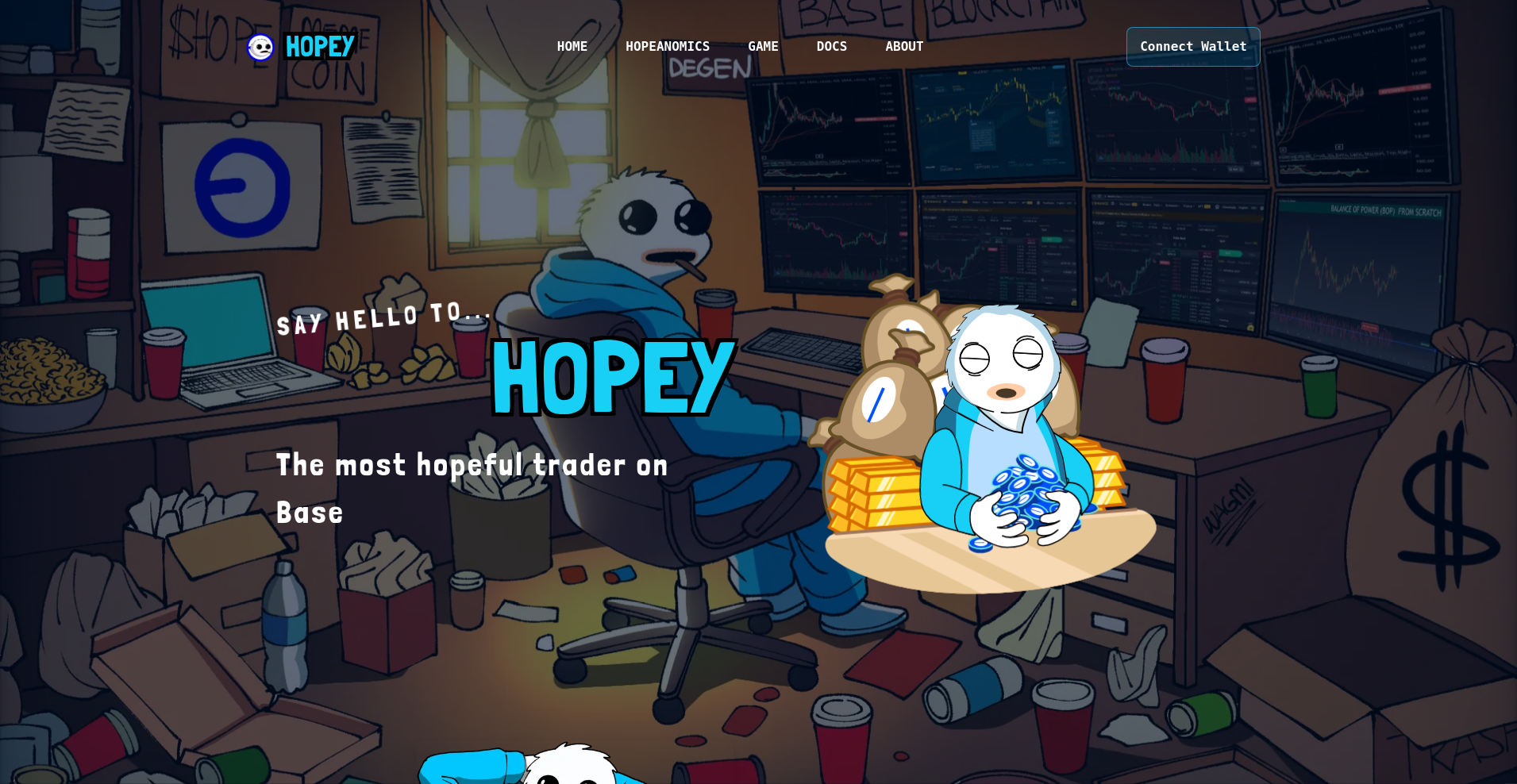Hopey ($HOPE) Review: A Data-Driven Look at Its Legitimacy, Risks, and Future Potential

What Is Hopey: An Introduction
Hopey is a memecoin project built on the Base blockchain, characterized by its narrative-driven branding revolving around a hopeful character named Hopey. The project emphasizes resilience and perseverance amid the tumultuous environment of memecoin trading, often marred by scams, rug pulls, honeypots, and bad trades. Central to its identity is a story of hope and determination, positioning itself as "the most hopeful trader on Base".
Technologically, Hopey integrates with popular Web3 tools such as MetaMask and Uniswap, facilitating users to buy, trade, and participate through Layer 2 solutions on the Base network. The project also features an interactive "Game of Hope," which encourages community engagement while reinforcing the narrative of persistence despite setbacks. This review offers an impartial analysis of Hopey's strengths, weaknesses, technical security, tokenomics, and the risks that potential investors or participants should consider.
The Team and Roadmap Evaluation
One of the critical gaps in the available data is the scarcity of information about the development team behind Hopey. The project’s narrative photogenic and branding are prominent, but no explicit details are provided about the team’s identities, backgrounds, or prior experience. This lack of transparency raises initial questions about credibility and governance—a common concern in memecoin projects, especially those reliant on storytelling rather than verifiable leadership. This focus on narrative is a common element in many narrative-driven memecoin strategies.
From the roadmap perspective, the publicly available data does not specify detailed milestones, development phases, or future plans. The focus appears to be on establishing liquidity, community building through social channels, and interactive features like the game. The mention of a long-term LP lock (69 years) suggests a commitment to security, but without a clear developmental trajectory, it is difficult to assess the project’s capacity for sustained growth or innovation.
- Establish liquidity with 100% LP, locked for 69 years
- Build community through Telegram and Twitter channels
- Launch interactive "Game of Hope"
- Integrate with Base blockchain and popular DeFi tools
- No publicly available detailed milestones or future roadmap phases
In sum, the team’s credibility and ability to deliver on long-term promises remain uncertain given the limited transparent data. The project’s emphasis on narrative and security features suggests a focus on stability and community trust, but the absence of concrete development plans warrants cautious optimism.
Hopey Security Audit Results
The security analysis of Hopey’s smart contracts is primarily based on an audit conducted by Cyberscope, a reputable audit firm. The audit assessment indicates a high security score of approximately 94.63%, which is a strong indicator of technical robustness. However, the audit documentation notes the presence of observed vulnerabilities classified as "high criticality."
Key points from the audit include:
- One major high-criticality vulnerability identified, requiring urgent attention or mitigation
- Ownership of the contract is renounced, decreasing the risk of code manipulation or malicious changes by developers
- Liquidity pool (LP) is locked for 69 years, providing a guarantee against rug pulls involving liquidity withdrawal
- The project utilizes standard security practices but has an identified critical issue that must be monitored
While the high security score suggests robust technical implementation, the identification of high-criticality vulnerabilities means that potential investors should seek further details on how these issues are being addressed and whether they pose real exploitation risks. Understanding how to interpret Cyberscope's reports is crucial here. Additionally, the audit's scope seems limited to the smart contract of the token, without information on broader platform security or backend infrastructure.
In conclusion, the security posture of Hopey appears strong on paper, but the presence of some high-severity issues serves as a reminder for due diligence. As always, smart contract vulnerabilities can be exploited if not meticulously addressed, so continuous monitoring and updates are essential.
A Breakdown of Hopey Tokenomics
Hopey’s tokenomics revolve around the $HOPE token, designed to serve as a core component of its community and engagement ecosystem. The token distribution, utility, and economic model appear straightforward, but detailed metrics are somewhat sparse in the provided data. Nonetheless, key aspects include the emphasis on security and sustainability through governance mechanisms.
- Total Supply: Not explicitly specified, but the initial liquidity covers the entire supply, with a focus on LP bonding
- Token Utility: Primarily used within the "Game of Hope" ecosystem and community engagement; potential governance rights are unspecified
- Distribution: No detailed breakdown provided, but LP comprises 100% of tokens at launch
- Vesting & Locking: Liquidity is permanently locked for 69 years, indicating a commitment against rug pulls
- Inflation/Deflation: Not explicitly mentioned; likely static supply or limited minting
Given the minimal data, the economic sustainability of Hopey hinges on community engagement, the success of the game, and ongoing development efforts. The long-term LP lock enhances perceived security but does not inherently guarantee growth or token appreciation. The lack of detailed token utility or governance features suggests that the project’s economic model might rely heavily on narrative and community sentiment, rather than focused token utility beyond trading.
Assessing Hopey's Development and Ecosystem Activity
Based on the available summaries and blockchain activity, Hopey’s development footprint appears primarily centered on establishing its liquidity, community channels, and interactive features. While social engagement via Telegram and Twitter is mentioned, the project’s actual development activity—such as updates, code commits, or new features—is not explicitly documented or visible in the provided information.
The launch of the "Game of Hope" and integration with the Base blockchain demonstrate a focus on ecosystem participation and user interaction. The absence of trading volume data or listings on exchanges suggests that the project is still in its early stages or heavily reliant on community-driven promotion. It is crucial to note that without observable growth metrics, active developer engagement, or expanding user base, the project's long-term traction remains uncertain.
From a security perspective, the locked liquidity and high audit scores indicate solid foundations, but community engagement and development momentum are equally vital. Projects that do not show consistent activity risk stagnation, which can affect their ability to sustain relevance and value over time.
What Investors Should Know About Hopey's Terms
Analyzing the provided documentation and available data reveals no specific legal clauses or complex terms and conditions that could pose additional risks or protections. The main noteworthy feature is the fully locked liquidity (69-year lock) and the renounced ownership of the smart contract, both positive signals for decentralization and security. The renounced ownership is a key aspect of responsible token management.
Potential red flags or considerations include:
- No explicit mention of compliance with regulatory standards, which could imply legal vulnerabilities if the project targets certain jurisdictions
- Lack of detailed terms of token utility, governance, or holder rights
- Absence of a clear dispute resolution process or legal framework for the community or investors
In sum, the project’s terms appear straightforward and security-focused but lack detailed legal safeguards or community rights documentation. Prospective participants should be cautious and seek more information if available, especially regarding future governance or legal protections.
Final Analysis: The Investment Case for Hopey
Hopey presents itself as a narrative-driven memecoin with a focus on community resilience and security. Key strengths include a highly secure smart contract with renounced ownership, a long-term LP lock, and a clear branding story that may resonate with community-minded users. The high audit score underscores technical diligence, and the utilization of popular DeFi tools facilitates user participation within the Base ecosystem.
However, significant risks loom primarily due to the scarcity of transparency about the development team, detailed tokenomics, and the project’s actual utility beyond the narrative. The security audit, while promising, revealed some high-criticality vulnerabilities that require ongoing oversight. The lack of growth metrics, active development, and an explicit roadmap leaves questions about the project's long-term viability.
- Pros / Strengths:
- High security score with smart contract audit
- Ownership renounced, LP locked for 69 years
- Clear branding and community engagement channels
- Integration with Base and popular DeFi tools
- Cons / Risks:
- Limited transparency about team and future development
- Presence of high-criticality vulnerabilities in smart contracts
- Lack of detailed tokenomics and utility outline
- Uncertain long-term ecosystem activity and growth
- No explicit legal or governance protections documented
In conclusion, Hopey is a project with promising security features and a compelling narrative, but its lack of transparency, ongoing security issues, and uncertain development trajectory warrant cautious participation. Investors and community members should perform further due diligence and stay updated on any new developments or audit disclosures before committing significant assets.
As always, approach such projects with careful risk management, especially in the volatile and often unpredictable landscape of memecoins and narrative-driven crypto ventures.

Amanda Harris
Technical Security Educator
Security professional passionate about the "human firewall." I translate complex crypto threats into simple, actionable security habits for everyday users.
Similar Projects
-
INBUVE
INBUVE Review: Is This Crypto Project a Scam? Crypto Scam Checker & Project Review
-
SPORT
SPORT Review: Is This Crypto Scam or Legit Investment?
-
RoiFeed
RoiFeed Review: Crypto Project Scam Checker & Analysis
-
Dogita
Dogita Review - Crypto Scam Checker & Project Review | Is Dogita a Scam?
-
SingularDEX
Comprehensive Review of SingularDEX: Crypto Scam Checker & Project Analysis